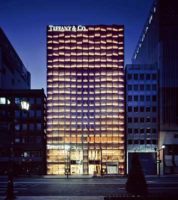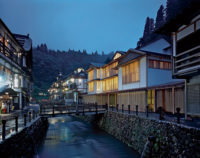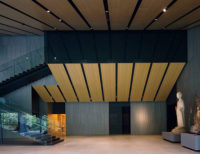Today, people in cities seem to most appreciate neighborhoods where they can enjoy both tranquility and vitality at the same time. Sanlitun SOHO is a sophisticated example of this model of urban development, combining a number of different uses with a sense of urban enclosure. It brings together retail establishments, offices, hotels, and residences, so it generates activity all day long. And by clustering its buildings along a curving, mid-block passageway, it creates the sense of a compact neighborhood with its own architectural identity.
Located to the south of Gongti North Road and to the west of South Sanlitun Road in the Chaoyang District of Beijing, the project continues the transformation of the once-seedy Sanlitun area into an upscale entertainment zone. That process began with Sanlitun Village, which was developed by Swire Properties and includes the Opposite House hotel designed by Kengo Kuma. Not to be outdone, SOHO China—one of the country's most successful developers—hired Kuma to master plan its own project and design the exteriors of the buildings too. Interiors were designed by a number of younger firms, including Sako Architects, MOD, and SPACE Ltd. SOHO envisioned its development as a busy hub for locals and tourists, with a broad assortment of boutiques, pubs, and restaurants, and plenty of creative companies incubating in the office towers. The 465,680-square-meter complex comprises five shopping malls with 128,000 square meters of retail space and nine towers of varying heights with 108,000 square meters of offices and 118,000 square meters of apartments. A roller skating rink and a waterscaped courtyard link the malls, a pedestrian shopping street, and an open plaza. Underground, the project provides 2,362 parking spaces for cars.
Kuma created a village of sensually curving towers all clad in blue, gray, and white glass-and-metal curtain wall, except for one tower in the middle that stands out with its orange and yellow skin. The design establishes an easily identifiable vocabulary of forms and colors that bring all the buildings together as a family. To meet daylight requirements, apartments occupy the south portion of the site, while offices reside in the north side to establish convenient communications with the main streets. By breaking the large complex into a number of towers and surrounding them with a continual outdoor space, Kuma was able to bring daylight deep into every building.
Due to its distinctive architecture, Sanlitun SOHO doesn’t actually establish much dialogue with its surroundings, but that can be considered a stance. Its strong identity, advantageous location, and high-density mix of functions have made the project a success. Although it began under the shadow of the 2008 world economic crisis, the development generated total revenue of 16.9 billion RMB by August 2011, according to SOHO China, and office occupancy more than 90 percent. Just as important, it attractive walking street and leisure plaza has made it one of the most popular places in Beijing.
People |
Products |











Post a comment to this article
Report Abusive Comment